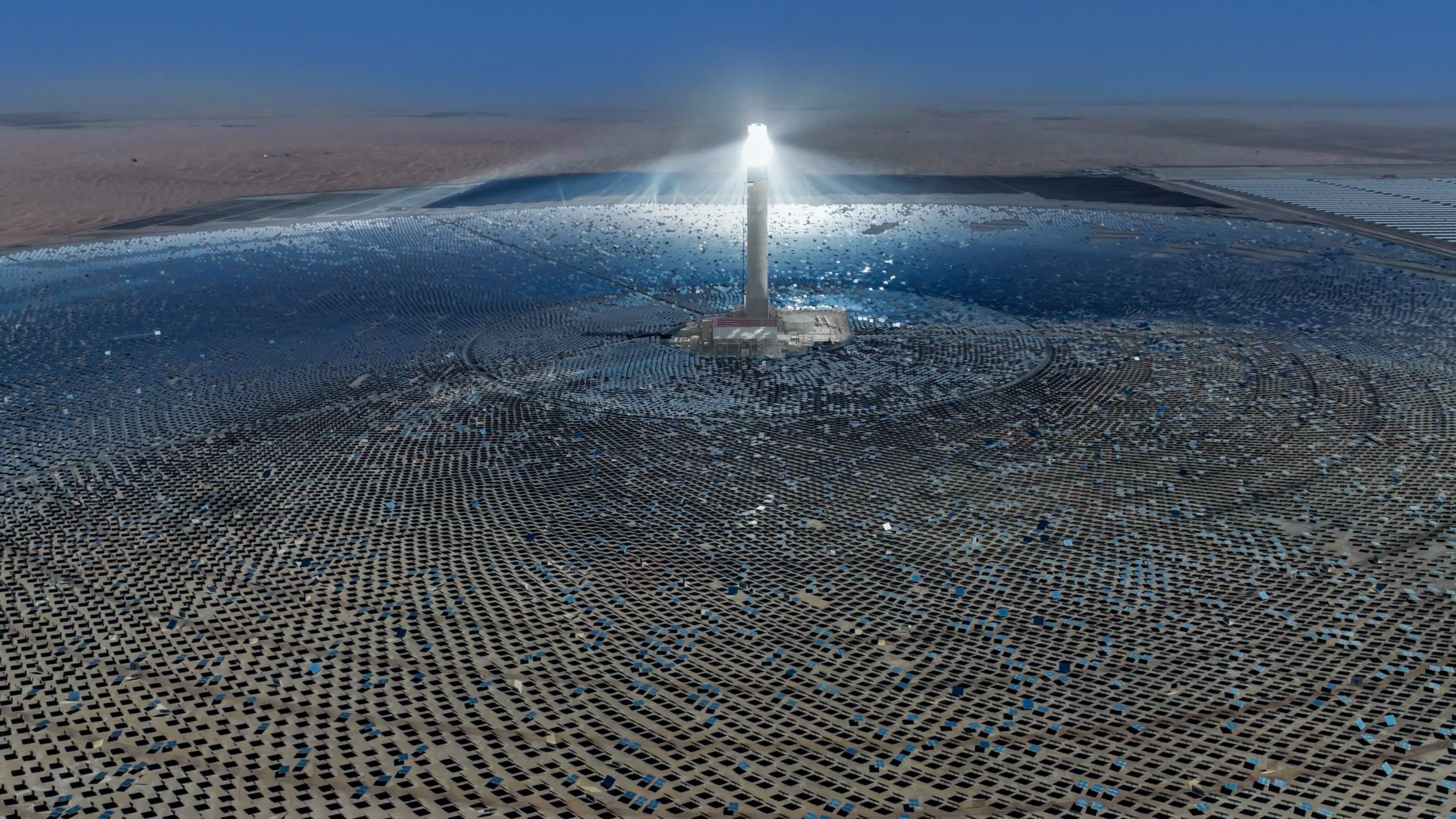
Vast specializes in concentrated solar thermal power energy systems. (Source: Vast Energy)
Concentrated solar power (CSP) faces tough odds. It may never win against the lower cost and abundance of natural gas for power generation or the economics of solar photovoltaic (PV).
It doesn’t need to, Vast Energy CEO Craig Wood says.
CSP, which uses mirrors to capture and concentrate the sun’s heat to drive turbines or engines to generate electricity, has other crucial supporting roles to play on electric grids and elsewhere.
“It’s not really competing with PV. It’s complementary,” Wood told Hart Energy while in Houston for CERAWeek by S&P Global. “We’re doing storage at long durations for nighttime power and heat.”
Just about everyone initially thought CSP was a power generation technology, and it sort of was, he said, until the Chinese invested about $70 billion in its solar PV supply chain to significantly lower solar production costs. Now, it is taking on a new role in thermal energy storage.
The company was created by a merger in December 2023 of Australia-based Vast Renewables with Nabors’ special purpose acquisition company Nabors Energy Transition Corp. It is now looking to scale its CSP technology and move into sunny regions needing longer-duration storage options.
RELATED
Mirrors, AI, Solar Offer ‘Killer Combinations’ for Energy Storage
Nabors’ Vast New Energy Source

The growth plans come as the U.S. and other parts of the world add more intermittent renewables to electric grids. The surge of renewables powering grids has created a need for improved reliability to better balance electric consumption and production.
Fossil fuels—specifically natural gas, coal and nuclear—have been the usual go-to for meeting peak demands. However, efforts to reduce greenhouse gas emissions have led to a push for more grid-scale batteries, which store excess electricity to release when needed. Problem is, the lithium-ion batteries typically store only a couple of hours of energy. CSP can complement PV, Wood said.
“PV gives you about the eight hours on average energy during the daytime,” Wood said. “You can build [CSP] right next to the PV. “The system stores the energy that arrives from the sun during the day, and then we can produce 12 to 20 hours of electricity by the night.”
Promising pairing
With global solar PV installations jumping to 358 gigawatts (GW) in 2023, up from 230 GW in 2022 by Wood Mackenzie’s estimates, the pairing of CSP and PV could prove promising. However, the energy sector has not seen much co-development, at least in the U.S., of CSP for energy storage paired with solar PV installations.
Wood pointed out that there is only about 7 GW of CSP globally.
“It’s not huge. But it is in all sunny markets around the world, apart from Australia. Interestingly, which is a bit of a quirk of our politics,” he said. “But to give you a sense, the most recent non-Chinese CSP plant that’s been commissioned is actually four plants co-located.”
The 950-megawatt (MW) fourth phase of the Mohammed bin Rashid Al Maktoum Solar Park was inaugurated in Dubai in 2023. The $4.3 billion phase, part of a $13.6 billion project, was developed by the Dubai Electricity and Water Authority and Saudi Arabia’s ACWA as Noor Energy 1. The fourth phase used three hybrid technologies: 600 MW from a parabolic basin complex (three units of 200MW each), 100 MW from the world’s tallest solar power tower at 262.44 m (based on molten salt technology) and 250 MW from photovoltaic solar panels, according to the solar park’s website.

At 15 hours, the project’s fourth phase is expected to have the world’s largest thermal storage capacity, provide energy to about 320,000 residences and lower annual carbon emissions by about 1.6 MMmt.
A 900-MW fifth phase became fully operational in June 2023, and a sixth phase for 1.8 GW is in the works.
In some regions, “it’s quite common to see that PV, CSP hybrid. And as we move towards greater levels of decarbonization, particularly on the power grid, that's where we expect to see CSP to be deployed in much, much greater volumes,” Wood said.
CSP has been challenged in the U.S. by high costs, reliability issues and market unreadiness. The obstacles can be overcome as the market opens for CSP, he added, with increasing pressure to reduce reliance on fossil fuels.
Evolving technology
In the past, thermal oil heat transfer fluid (HTF) was used for CSP, but it was limited to operating at about 400 C—not hot enough to be efficient. Second-generation technology moved to higher temperatures using molten salt to store energy, but that made it difficult to control the thermal process, Wood explained.
Vast’s technology aims for lower costs and improved efficiency with a modular sodium loop system and smaller 150-ft towers, which are less expensive to build.
“We then link multiple of those little towers together by liquid sodium using pipework to actually flow sodium metal around the field. That allows us to bring the energy at a very high temperature back to the central tower block,” Wood said.
Sodium HTF can deliver higher temperatures and greater reliability, according to Vast.
“Our heliostats are again very cheap. It’s quite a reliable system because we’ve got multiple towers. If one of them goes offline for whatever reason, we can keep the rest of the system running.”
Vast’s CSP v3.0 technology system reflects and concentrates sun rays onto receivers that capture solar energy as heat in sodium. The heat is then transferred to molten salt for high density storage.
The company is also carving out its place in the low-carbon hydrogen production market with its SM1 project in Australia. It uses CSP-delivered heat and power to produce hydrogen using an electrolyzer. The hydrogen is then combined with captured CO2 to produce green methanol.
“We’re developing a bunch of projects in Australia at scale … from 100 to 250 MW. Here in the U.S., we’re also working to stand up and develop an organization, [with the] first project likely to be right here in Texas,” he said.
Vast is always looking for partners and investors, Wood added.
When it comes to solar, there is a big opportunity to shine. “By 2050, it’s huge for CSP and it’s really driven by nighttime power generation in sunny places and greenfields,” Wood said.
Recommended Reading
CEO: Continental Adds Midland Basin Acreage, Explores Woodford, Barnett
2024-04-11 - Continental Resources is adding leases in Midland and Ector counties, Texas, as the private E&P hunts for drilling locations to explore. Continental is also testing deeper Barnett and Woodford intervals across its Permian footprint, CEO Doug Lawler said in an exclusive interview.
Green Light for ConocoPhillips’ Eldfisk Nord
2024-02-28 - ConocoPhillips is expected to begin production at its Eldfisk Nord project before the first quarter ends.
For Sale, Again: Oily Northern Midland’s HighPeak Energy
2024-03-08 - The E&P is looking to hitch a ride on heated, renewed Permian Basin M&A.
To Dawson: EOG, SM Energy, More Aim to Push Midland Heat Map North
2024-02-22 - SM Energy joined Birch Operations, EOG Resources and Callon Petroleum in applying the newest D&C intel to areas north of Midland and Martin counties.
Chevron Hunts Upside for Oil Recovery, D&C Savings with Permian Pilots
2024-02-06 - New techniques and technologies being piloted by Chevron in the Permian Basin are improving drilling and completed cycle times. Executives at the California-based major hope to eventually improve overall resource recovery from its shale portfolio.






